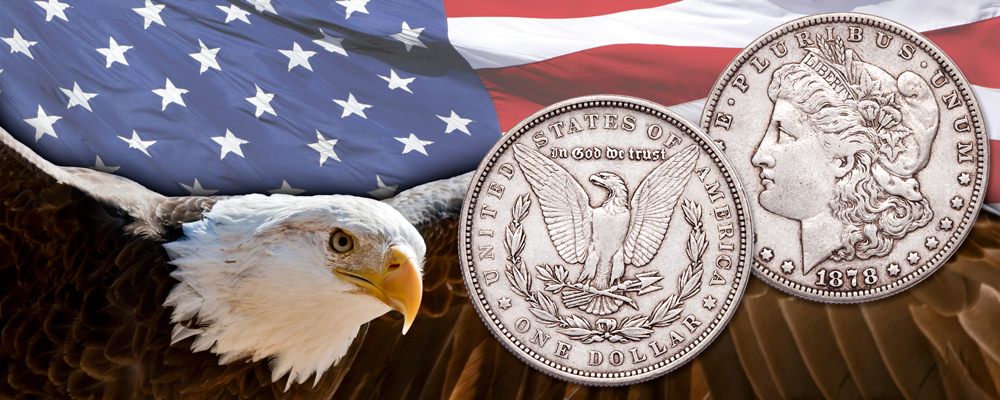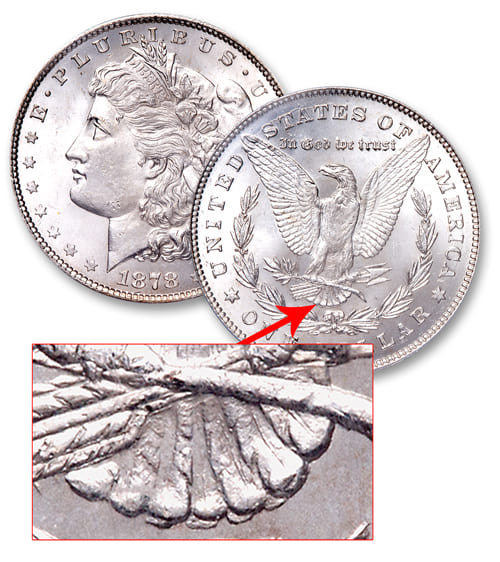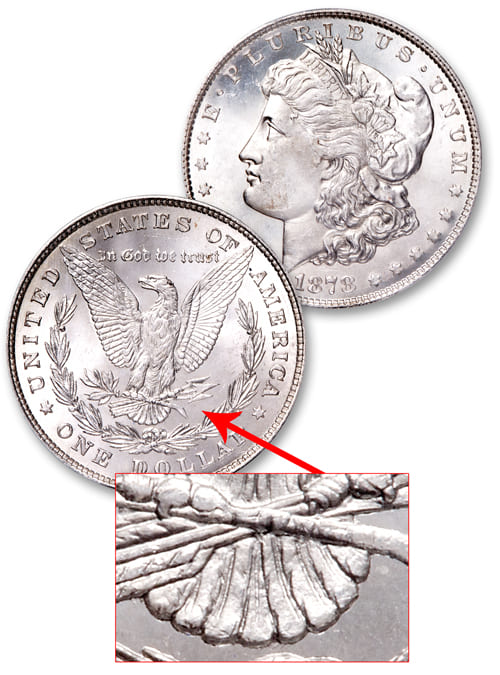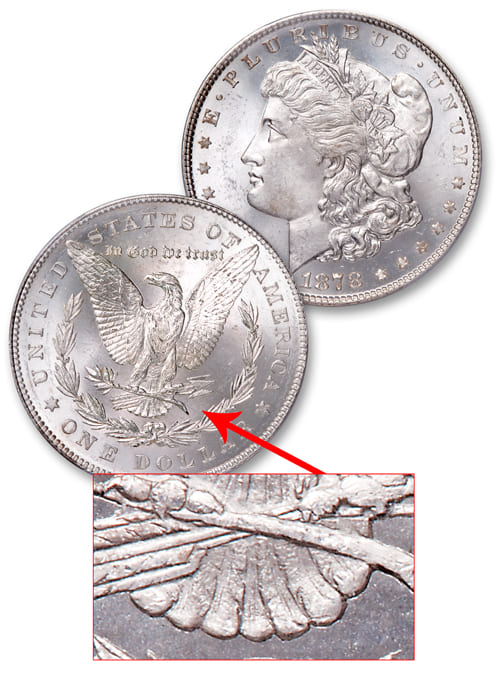Eagle Tail Feather tall tale becomes the stuff of legends

When the U.S. Mint released first-year 1878 Morgan dollars, the eagle on the reverse sported 8 tail feathers. But supposedly ornithologists stepped forward and claimed eagles had an odd number – 7 tail feathers, so the presses were halted and the design changed from 8 to 7…
Exactly how many tail feathers do Bald Eagles have?
This got me thinking… just how many tail feathers does a bald eagle have? Turns out they have 12. The tail feather story has been the stuff of numismatic lore for generations. And because generally the U.S. Mint doesn’t share their reasons for doing things, perhaps it was the way the public explained the switch from 8 tail feathers to 7 within just a few weeks of the new Morgan silver dollar’s release.
Not only do the first coins of 1878 represent the start of this popular dollar series, but the tail feather controversy also created several exciting first-year varieties. In March 1878, the Philadelphia Mint struck the first Morgan silver dollars.
Only in 1878 and only at Philadelphia
Those first Morgans are the dollars with the 8 Tail Feathers reverse, produced only in 1878 and only at the Philadelphia Mint. After striking about 750,000 Morgans with the 8 Tail Feathers reverse, Mint Director Linderman ordered new hubs for the obverse and reverse, lowering the relief and changing the tail feathers to 7 to match the number shown on other U.S. coins.
The Bland-Allison Act required the Treasury to strike millions of 90% silver dollars each month. Because preparation of new dollar dies for all of the mints would take several weeks to produce, the Philadelphia Mint simply impressed the new 7 tail feather design over the older 8 tail feather dies. This created the 2nd Philadelphia variety – the 1878 Doubled (7 Over 8) Tail Feather Morgan. (This variety, once known as 7 over 8, is now known as “Doubled Tail Feathers.”)

1878 Doubled (7 Over 8) Tail Feather Morgan.
The new 7 Tail Feather variety was the last reverse design for 1878. And yet, this last 7-feather reverse has two distinct arrow feather designs: the Parallel Arrow Feather (PAF) of April, and the Slanted Arrow Feather (SAF), May’s modification. By mid-April, the Carson City and San Francisco Mints had received their coin dies and began preparations to strike the first-year Morgans. The 7 Tail Feather reverse (with Parallel Arrow Feathers) was used at all 3 mints: Philadelphia, Carson City, and San Francisco that first year. Philadelphia also struck a number of Morgans with the Slanted Arrow Feathers.
First-year coins are always popular and especially so when they’re Morgan dollars. Little nuances like the tail feathers spark interest in the series and leads to the study of die marriages and VAMs, which further collectors’ knowledge. Certainly in our 70+ year history, anytime we’ve been able to offer the 1878 Morgan dollar Tail Feather Set, it immediately sells out, which is a testament to its popularity. It just goes to show striking 5 different reverse varieties in a matter of months was business as usual as for the U.S. Mint, but for collectors, it created a spectacular first-year Morgan dollar set that’s always in demand!






I’ve done extensive research on the 1878-8TF & 7TF. Ornithologists at Cornell and William & Mary College says without exception Bald Eagles have always had 12 Tail-feathers even in 1878. I’ve had changes made to the
RED BOOK through Dennis Tucker at Whitman in the past. In my discussion today with him, he says Mr. Bowers may make some changes on the Tail-feather situation.
Steve McGowan USMC [ret] Collecting for 30 years.
Very interesting Steve! Thanks for the info. It’ll be interesting to see if/how they make changes.
LCC seems to have two versions on the Tail-feather Tale. one being ” The Public ” the other an obscure reference of “Ornithologists” that lead Director Linderman to order the change. Mercanti’s 12 Feather Design on the ASE is correct, I cannot say if this was a guess on his part or not. Perhaps Mr. Sundman can contact Mr. Mercanti and ask him. Either way we now know the PHD’s at Cornell and William & Mary on the American Bald Eagle speak the truth. I have serious doubts that Publishers are willing to take up the challenge to make the change in so many Books and Articles that have touched on the subject. Will LLC ???
We can’t go back to change the past, and recreate the 1878 Morgan’s design with the correct number of tail feathers. But nowadays, as you pointed out (and also mentioned in the post above) most people agree Bald eagles have 12 tail feathers. In fact, on page 2236, Q. David Bowers mentions the 12-tail feather situation in his Silver Dollars & Trade Dollars of the United States, A Complete Encyclopedia, Vol. II. The whole tail feather question has generated a lot of interest in the series.
Certainly with computer-aided design it’s easier today to place 12 feathers on the reverse of a coin. In 1878, many of the steps in the coin’s design were done by hand.
The switch from 8 tail feathers to 7 happened within the first few weeks of Morgan dollar production. According to numismatic lore, it was because eagles had an “odd number of tail feathers.” There are several different versions of the “story,” and we may never know the real reason the feathers changed. But research and interest in old U.S. Mint records continue to bring new information to light and perhaps someday, details about the switch from 8 to 7 tail feathers will be uncovered.
Simply put,the 1878-8TF is not an error Coin. Every Morgan Minted afterwards with 7 TF’s is the error. But, the so called experts will not accept this fact. Mr. Tucker at Whitman Publishing claims ” Artistic Design ” was the determining factor as to the TF Count. Yet, Linderman overruled the designer and made the change based on nothing in fact. All he said was, ” It was important to make the change “.
Thank you for your extended interest in our article, Mr. McGowan! I don’t know that any numismatic authorities have ever referenced either version of the coin as an error (especially given that the technical numismatic definition of “error” is “a coin improperly produced but not detected, and released by the mint”). Our article defines the different tail-feather versions of the first-year Morgan as a variety – a change in the design for certain, but nothing more. The fact that the change in the tail feather design was made intentionally by mint officials removes its eligibility for error status. We’re simply fascinated by the tale of the Morgan Tail Feathers as a nice numismatic story that’s filled with interesting history.
Not to beat a ” Dead Eagle “….The statement that “previous Coins had 7 Tail-Feathers ” is a dubious one at best. Close examination of Coins featuring the Eagle Design show any number of Tail-Feathers ranging from as few as 4 up to 14 and almost every other number in between. There was no specific number at all. So ” Artistic-Interpretation ” by the Designer-Engraver should have taken precedence. Linderman never explains his decision other than to say, ” The change was important “. Since he went ahead with the change he most certainly must have thought that George T. Morgan had made a Design error. In Morgan’s Sketch Book he only says that he studied from an Anatomical perspective, the Eagle design. And did not address or discuss the actual Tail-Feather count. Perhaps his opinion on Linderman’s change can be found ???? As of yet I haven’t been able to. Though John Mercanti has been on Twitter since 2011 he’s only posted one comment and has not addressed the Tail-Feather debate, or why he chose the correct number of 12. On another topic, Mercanti in his Books on the ASE mentions the Denver Mint as contributing in the production of the 1986 ASE. My FOIA request has been denied twice for any Data or info on the subject. The US Mint only says there are no Records available. As a former Purchasing Manager I find that statement ridiculous. At the very least there must exist a paper trail. And, does anyone truly believe that the first few ASE’s at Denver were not saved ? What would an Authenticated Denver Mint 1986 ASE be valued at ????
Come on Littleton, there must be a little bit of curiosity ? I started my Collection Years ago with purchases from you Guys and Girls at Littleton.
Best Regards.
I was lucky to score 3 of these coin. All 1878 1 a 1878s I do believe all 3 would be back with die cracks and errors love to share picture’s.
Great find, William! You’re welcome to share your coin photos with us on our Facebook page. We’d love to see them. Have a good day! -Rick